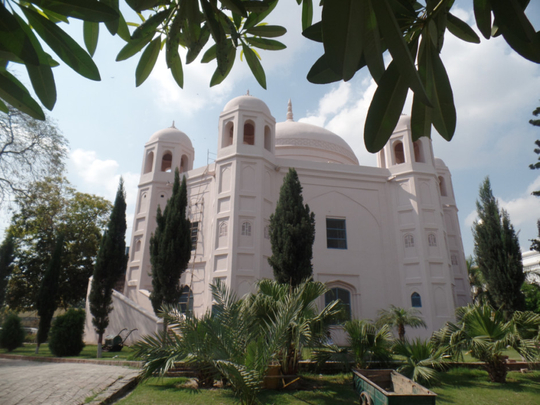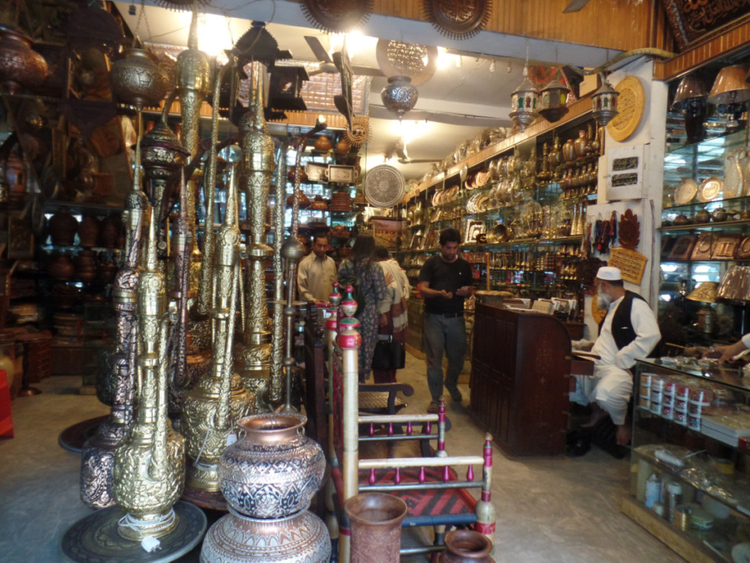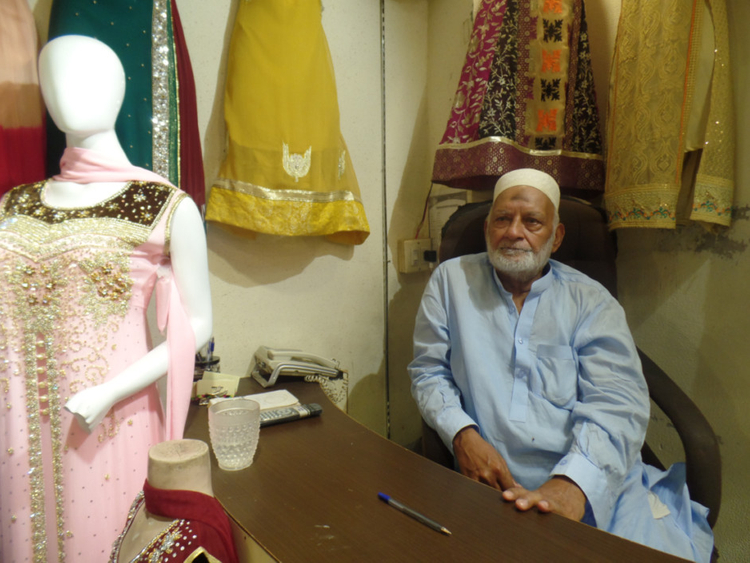
Mohammad Ilyas sits behind the counter of his shop in Lahore’s historic Anarkali Bazaar. He has a white beard and wears a prayer cap. Behind him on the wall hang headless mannequins attired in a variety of colours — pink, blue, black.
Ilyas first started working in Anarkali in 1958. “You were not even born then,” he tells me. “At that time, in the whole of Punjab there was only one market, this Bano Bazaar. Especially for female shoppers — they felt as if they were walking within the four walls of their own home.”
Ilyas’s shop is located in Bano Bazaar, one of the markets within Anarkali Bazaar that is especially popular among women for items such as clothes, bangles, henna, shoes and accessories.
Anarkali Bazaar has its own distinct character. It is named after a slave girl who, according to legend, was immured by Mogul Emperor Akbar for having an affair with his son Salim. The bazaar is located in central Lahore, the second most populous city in Pakistan, which is renowned for its architectural heritage from the Mogul and British colonial eras.
The bazaar has two parts: Old Anarkali and New Anarkali. Old Anarkali is known because of its offering of traditional foods. However, the shops in New Anarkali are more interesting. They sell a variety of items, including traditional dresses, shoes, jewellery, bangles, sweets, sports goods and handicrafts. Within New Anarkali there are individual market areas such as Bano Bazaar, Dhoni Ram Lane and Paan Gali.
Having worked for more than half a century in the bazaar Ilyas has served customers from different walks of life, including the political elite. “The family of Amir Mohammad Khan, the Governor of West Pakistan, would come to the market, so did the wife of Chaudhry Zahoor Elahi [a prominent politician]. And other big families, political leaders used to visit because there was no other market.”
In recent times modern shopping malls have opened in Lahore. There you will find everything from designer salwar kameez boutiques to western brands and restaurant chains. These places are popular among the nouveau riche and what is known colloquially as the “burger crowd”.
But what makes Anarkali special is its authentic look and atmosphere. It is a place that captures the indigenous bazaar life of Lahore. A street vendor sells dates close to a local mosque with a blue dome (“Neela Gumbad”) that is a local landmark. Women shoppers with plastic bags stop at a popular restaurant to enjoy some “dahi bara” (a traditional yogurt snack), “fruit chaat” (spiced fruit salad) or fresh fruit juice. A beggar woman follows visitors getting out of vehicles as they make their way to the shops.
According to Ilyas, compared to more modern shopping areas such as Liberty, Anarkali Bazaar offers value for money. “We sell dresses for about Rs2,000 [Dh70] while the same cost Rs6,000 at these modern markets. Even though our profit margin is small, we have a good variety [of clothes].”
I walk into a run-down hotel on the main street in New Anarkali. The manager, Abdul Wahid, appears tense at first, but soon relaxes when he hears my queries about Anarkali market’s history. He takes me out into the street to show me the landmarks. “Over there Akbar had Anarkali immured,” he says. “And there’s the tomb of Qutb Al Din Aibak.”
Qutb Al Din Aibak was a prominent 11th century ruler of Delhi who died after falling from a horse while playing polo.
I ask if Anarkali’s story is true. “It must be, I think,” Wahid says.
A hawker selling shoes joins our conversation. “Her tomb is in the Secretariat,” he says. Some historians have raised doubts about the accuracy of the legend of Anarkali, and the identity of her tomb is a mystery. There is no mention of her in Emperor Jahangir’s autobiography, nor in other royal accounts from that period.
The Punjab Secretariat is a heavily guarded public building located not too far from the bazaar. The so-called tomb of Anarkali is hidden within the secretariat. Anarkali’s tomb also serves as the historical record office of the Punjab Archives. The grave (and the archives) are located inside a grand Aladdin-style building.
Visitors are forbidden from taking pictures inside the tomb. There are various old framed photographs, notices and archival material. In one quiet corner I find the supposed grave of Anarkali. It feels surreal to visit the final resting place of a woman whose name has inspired iconic motion pictures, books and plays.
A page copied from an old book on Lahore by Syed Mohammad Latif, dated 1892, is displayed nearby. It describes the story of how Akbar supposedly ordered the immurement of Anarkali when he saw a reflection of her smiling at Salim (afterwards Jahangir) in a mirror. She was made to stand at a designated spot, and bricks were laid all around her until the space was completely enclosed. The note claims that Salim grieved over Anarkali’s death, and when he became the emperor, he had an immense superstructure built over the sepulchre. On the top of it are inscribed the 99 names of Allah, and on the side, a Persian couplet purportedly composed by Jahangir: “Ah! Could I behold the face of my beloved once more, I would give thanks unto my God until the day of resurrection.”
Anarkali is said to have died in AD1599. But how old is the bazaar named after her? It is hard to put an accurate date to it. Ilyas claims that the bazaar has existed for at least 1,000 years. Others claim the market is around two centuries old. In her book “Lahore: Topophilia of Space and Place”, Dr Anna Suvorova says the name Anarkali (which means a pomegranate bud) started being used in the neighbourhood and streets near her tomb after the arrival of the British who turned it into a church in 1850.
Amid the rush of motorcycles and rickshaws in Anarkali Bazaar, a young kulfi seller is pushing his cart in the narrow street. He has been selling the traditional ice-cream for around four years. “We prepare it ourselves. I am here from early morning to midnight,” he says.
One of the more prominent personalities who have visited Anarkali Bazaar is the current Prime Minister Nawaz Sharif. “He has come to this shop many times,” Ilyas says. Ilyas says Sharif was fond of a chickpea dish from a vendor. “He would tell him to add a boti [piece of meat], and then sit here and eat.”
The discussion turns to high food prices. “People are dying of hunger. Now okra is Rs120 a kilo. There was a time people gave it away for free. Same is the case with tomatoes ... As for meat, all the poultry business is controlled by Hamza Shahbaz [the prime minister’s nephew]. He decides the rates. This is why it’s been destroyed.”
One of the major problems Anarkali faces is lack of adequate parking, because of which many shopkeepers worry about losing business. “The biggest reason why business has been destroyed here is there’s no place to park vehicles. Customers are forced to park their cars at Mall Road,” Ilyas says.
Mall Road is one of the famous old roads of Lahore built during the time of the British, along with others such as McLeod Road and Napier Road nearby.
The construction of the Orange Line in Lahore, a section of the city’s Metro project that will have a stop at Anarkali Bazaar, is also affecting business here. “They have dug up the whole of Lahore,” says Ilyas.
The project has also raised concerns about the threat to heritage sites. Many Old Anarkali residents have held demonstrations against the proposed demolitions.
Besides, a bomb blast in 2013 in Old Anarkali that killed five people and left nearly 50 injured has hit the footfall.
However, Ilyas says, it was not always so dangerous. “Earlier, women could safely be out until 2am. There was so much security.”
Another characteristic of the market, I find, is that the shopkeepers are more interested in discussing the way the country is being run, instead of its history and heritage. Politics has always been a part of the traditional bazaar life. The marketplace is where people have been exchanging news (and criticising governments) for centuries.
For Ilyas, taxes are a particular sore point. “We are paying taxes, yet they keep adding to our burden. The government should impose taxes on those who are not paying up.”
Ilyas says Sharif has lost touch with people. “As chief minister Sharif was a very good man but he’s changed after he became prime minister.”
Ilyas narrates an anecdote from Sharif’s earlier days. “When he was chief minister he used to come to Gawalmandi [a popular area in central Lahore located near Anarkali Bazaar ] ... He would wake people sleeping outside and give them money from his pocket. He helped so many people back then.”
I make my way to Paan Gali, a narrow alley of shops. Paan is a traditional preparation made of rolled-up betel leaf stuffed with areca nut, spices and sometimes tobacco. Most of the shops here sell betel leaves. Others offer an assortment of goods such as spices and clothes. Paan Gali is also famous for selling Indian products.
Anarkali Bazaar reflects the religious diversity of Lahore, being home to a very old Hindu temple as well a church.
For those with a sweet tooth, Anarkali has a lot to offer. At Jalandhar Motichoor House, a shop established in 1922, I meet Haji Layaqat Ali who has worked here for 40 years. It sells a range of colourful sweets such as laddoos, barfi and pista. He shows me a booklet about his shop which details its history, and of course, there’s a mention of its most famous patron, Sharif, who apparently used to order motichoor laddoo from this shop when he was in exile in Saudi Arabia.
Then there is S. Mohkam ud Din & Sons, a prominent old bakery. It was established by Shajjar Naqvi’s grandfather in 1879. “We are the oldest in this area ... Now I am running the third generation of this business,” says Naqvi. He claims it was the subcontinent’s first professional bakery. Naqvi’s grandfather died in 1947. “At that time he was 101 years old. After that it was my uncle, and then my father, who looked after the business.”
For Naqvi Anarkali is not just business — it is also where he grew up. “The shops would open at 6am and close around the time of the Maghrib Adhan. I played, studied and grew up here. I have so many memories here.”
Since 1995, when Naqvi took over, he has seen a lot of changes. “Encroachments have increased. The old people have left. Money-minded people have come here now. The honest businessmen have left. They have rented out their shops or sold them.”
Naqvi says his products have no preservatives or artificial ingredients. “We use old British recipes.”
“We don’t have walk-in customers. Our customers have been coming to us for years,” he says.
Naqvi has done a course from Salford University in the UK, specialising in baking and confectionary. Most of his clients are elite Christians. His cakes are much in demand on special occasions such as weddings. “Rowan Williams, the Archbishop of Canterbury, came here. My father also served many British bishops.”
His assistant brings over a variety of biscuits in a plate. Naqvi picks up one, known as finger biscuits. “Why are they called finger biscuits? They were inspired by Lady Harrison, the principal of Mayo School of Art before partition. My grandfather was inspired by her fingers and created these biscuits. They were earlier called Lady Harrison biscuits, but now they are just known as finger biscuits.”
Another old timer is Malik Abdul Qayuum at Chaman Saree House. He has been in Anarkali since 1950. “Those days were good. Few people had cars or motorcycles.” Today he finds there are fewer customers. “There were no plazas earlier ... there was only Anarkali.”
His shop sells various types of traditional clothing for women such as sarees, lehengas and gharara. What attracts women to his shop? “It’s an old shop. It’s well-known and satisfied customers return to our shop. Many of our customers are regular.”
Each shopkeepers in Anarkali has a different customer experience story to share. Nasiruddin is a relatively new retailer who has been here for around six years. He sells khusas — traditional shoes worn during weddings. His clients are both men and women. “Women customers like to bargain more than men, asking for this design or that design. Male customers, on the other hand, bring their sherwani [traditional wedding coat] along and simply ask for a match.”
There are also a few sports goods shops in Anarkali. Benjamin Bhatti has worked at Pakistan Sports for the past 22 years. The shop sells all sort of sports equipment from cricket bats and tennis rackets to footballs, board games and branded T-shirts for local cricket leagues. A lot of his goods come from Sialkot, a sports goods manufacturing hub. Bhatti tells me famous Pakistani cricketers such as Abdul Razzaq, Rana Naveed ul Hassan and Imran Nazir have visited his shop.
He remembers a time when international cricket stars visited Anarkali Bazaar. “The West Indies players came 20 years ago. South African players came in 1997 for a tournament at Gaddafi Stadium. Now the security situation is such that they are afraid to visit the market.”
Some shopkeepers such as Ilyas are nostalgic about the market’s past. “There’s more greed now. People run after money more which wasn’t so before,” he says wistfully.
Syed Hamad Ali is a writer based in London.














